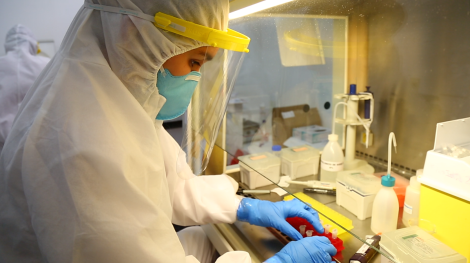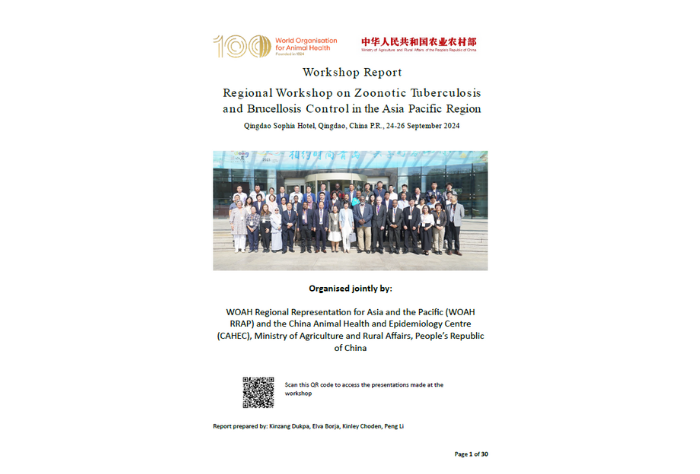
Organised jointly with the China Animal Health and Epidemiology Centre (CAHEC)
Bovine tuberculosis (bTB) is a chronic bacterial disease of animals caused by members of the Mycobacterium tuberculosis complex primarily by M. bovis, but also by M. caprae and to a lesser extent M. tuberculosis. It is a major zoonotic disease, and cattle are the main source of infection for humans. It also affects other domesticated animals such as sheep, goats, equines, pigs, dogs and cats, and wildlife species such as wild boars, deer and antelopes.
Zoonotic tuberculosis (zTB) is a form of tuberculosis that is transmitted from animals to humans, mainly through the consumption of raw or undercooked animal products, contact with infected animals or their secretions, or inhalation of aerosols. Zoonotic TB is a form of TB in people predominantly caused by a closely related species, M. bovis, which belongs to the M. tuberculosis complex (MTBC) which includes several species that can infect humans and animals. The most common cause of zTB is Mycobacterium bovis, which is also responsible for bovine tuberculosis (bTB) in cattle and other domestic and wild animals. zTB poses a serious threat to public health and animal health, especially in low- and middle-income countries where the disease is endemic and control measures are inadequate.
The current status and needs for zoonotic tuberculosis are summarized in the Roadmap for Zoonotic Tuberculosis1, which was published in 2017 by the World Health Organization (WHO), the Food and Agriculture Organization of the United Nations (FAO), the World Organisation for Animal Health (WOAH), and the International Union Against Tuberculosis and Lung Disease (The Union). Of the ten million people currently infected with new active TB, 140,000 are estimated to be new cases of zTB (1.4%) of which approximately 11,400 (8.1%) died. To support the Roadmap for Zoonotic Tuberculosis and as a call for action to tackle zTB in people and animals, WOAH has developed guidelines for alternative strategies for TB control in livestock. The objective of these guidelines is to provide alternative strategies for control of Mycobacterium tuberculosis complex infection in livestock.
Brucellosis is a neglected zoonotic disease of economic importance that is endemic in most of the lower and middle-income countries in the world, including the Asia Pacific region. Important species affecting food animals include Brucella abortus in cattle, B. melitensis in small ruminants, and B. suis in pigs. Besides being an occupational hazard for people working with animals such as livestock farmers, veterinarians, abattoir workers, laboratory workers, etc. through direct contact, the disease can be transmitted indirectly to humans via the consumption of non-pasteurised milk, and milk products. Brucellosis can result in economic losses in terms of reduced production due to infertility, abortions, decreased milk production, and costs for prevention, control, and elimination.
The WOAH Regional Representation for Asia and the Pacific (WOAH RRAP), supported by the WOAH Reference Laboratories for Brucellosis in China and Thailand, organised a Webinar on progress and challenges in brucellosis control in the Asia Pacific region in 2021. During the webinar, key updates and challenges in brucellosis control were discussed. This was followed by the “Virtual workshop on brucellosis control in the Asia Pacific region” organised jointly by WOAH RRAP, the WOAH Collaborating Centre for Food Safety, Rakuno Gakuen University, Japan, and WOAH Reference Laboratories for Brucellosis based in Thailand, South Korea and Italy. These workshops recommended that WOAH and its Reference Laboratories continue to engage its Members in understanding the progress, gaps, and challenges faced in brucellosis control in the region so that appropriate support may be provided to countries.
Therefore, a regional workshop on zTB and Brucellosis was jointly organised by WOAH RRAP in collaboration with the China Animal Health and Epidemiology Centre (CAHEC), a WOAH Collaborating Centre, with the following objectives and outputs.
A total of 50 participants, including 20 country representatives from 19 Members (Australia, Bangladesh, Cambodia, China P.R., Indonesia, Japan, Laos, Mongolia, Myanmar, Malaysia, Nepal, New Zealand, New Caledonia, Sri Lanka, Thailand, Papua New Guinea, Fiji, Vanuatu, and Vietnam) and local observers attended the workshop. Experts from WOAH Reference Laboratories and Collaborating Centers from China, Japan and Thailand supported the workshop. The China Animal Health and Epidemiology Centre (CAHEC) under the Ministry of Agriculture and Rural Affairs (MARA) of the People’s Republic of China provided logistics support for the workshop.
Dates: 24-26 September 2024
Location: Qingdao, China, P.R.
Participation: By invite
(Qingdao, China) zTB Brucellosis Workshop Report


